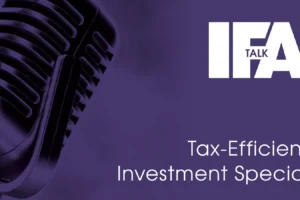Timber! Neil Martin Learns Some Unexpected Things About Cautious Management from Henderson’s Chris Burvill
 Chainsaw envy was one thing I had not expected to experience when talking to Chris Burvill, Director of UK Equities at Henderson Global Investors. But then, it was an unconventional conversation to start with.
Chainsaw envy was one thing I had not expected to experience when talking to Chris Burvill, Director of UK Equities at Henderson Global Investors. But then, it was an unconventional conversation to start with.
We had been talking about his role as lead manager of the Henderson Cautious Managed Fund, when I asked him what he did to relax? Bear in mind that for over 20 years (he was previously at Gartmore, Investec and Commercial Union), he has been a steady hand on the tiller on investment situations that offer a conservative outlook, looking to steer a course through both calm and choppy waters.
As befits a manager whose fund is not designed to be on the front line, his thoughts tend to come with a sharp focus and clear reasoning learnt from long experience. This is a man not prone to marketing jargon, or one who indulges in City speak to hide a two-minute view of the markets. This is the man you’d want on the other end of the line when your portfolio is in freefall.
Mind Those Teeth
So, when it came to his hobbies, I wrongly guessed he might admit to stamp collecting, collating a butterfly collection, or maybe studying mediaeval German poetry in a bookilined study? I was surprised, then, when he said that he likes to relax with a very large chainsaw.
“I’ve got this ridiculously large chainsaw,” he explained, with a wry smile. “To which my wife draws every analogy that women do.”
Now, I happen to own a small electric chainsaw myself, so for some inexplicable reason I felt a bit inadequate when mentioning this – hiding my embarrassment with ‘manly’ talk about what should happen if the chain came off (a thought that keeps me awake at night). As one who is obviously more knowledgeable than me, Burvill politely explained that it’s not the chain that is the worry, but the way it can bounce off the wood and “…go through people’s heads…”
Hard Hat
I’ll explain what Burvill does with his massive chainsaw at the end of this report. But first, let’s turn our attention to the Henderson Cautious Fund – and to my first question. Given that we’re at that stage of the recovery when talk of caution and safe harbours is receding, are these funds becoming harder to market to the private investor?
Back came an honest answer. “Absolutely. I’m trying to capture investors in both sides of the market, the markets goes down and I say oh well, hopefully we won’t go down as far as the market, and the market goes up and we’ll say don’t worry, at least you’ve got some exposure, but that arguably is exactly the point for retail investors.”
Safety Stance
The Henderson Cautious Managed Fund is a mixture of blue-chip equities, bonds and cash. Its whole reason for being  is to provide income and capital growth, and to have less volatility than a pure equity fund. The fund’s yield was running at 3.3% at 30 April.
is to provide income and capital growth, and to have less volatility than a pure equity fund. The fund’s yield was running at 3.3% at 30 April.
The asset class breakdown of the fund is just over half in equities (stalwarts such as HSBC, BP and Royal Dutch Shell); bonds at around 33% (the biggest being United Kingdom Gilt Inflation Linked 2.50% 2016); and the remainder in cash.
The idea of the Henderson fund is to offer some balance to volatility, although Burvill did admit that there’s only so much they can do in difficult times. “I need to be careful, we are only in equities and bonds, we don’t hold gold, and we don’t hold property directly, as some of our competitors do.
“I still feel there’s a responsibility with the investor. If markets go down, if interest rates go flying, and bonds do badly, and supposing there’s a high inflation environment, and equities struggle, then I’ll obviously do the best I can to mitigate that – but you know, I am beholden to the markets.
“And if markets fall, I don’t hedge, I don’t sell the futures, anything clever like that. There’s a responsibility on the individual investor not to expect miracles from the fund when markets are down.”
Taking Responsibility
Asked whether people will move away from the fund now that we are in a less cautious time, Burvill was clear. “Even if you are positive about the market, extremely positive, does a cautious fund not make sense to you? Because what it’s doing is giving some exposure to the market – within our sector we have quite high weightings in equities – but we are giving them a little bit of optionality.”
“If shares have gone a little bit too far, too soon, if there’s a bad day in the market, we’re more likely to be buying, because of the way the fund is constructed. Whereas a full-on equity, high beta equity fund is a one way bet: if markets go up you’ll do very well, but if they go down, you don’t have much in reserve. So I fully accept that if markets go up, it’s going to be hard for us to compete against 100% invested equity funds, although over the very long term, we can nearly keep up with the all-share, despite having far too much cash…”
There is much that the management can do to shield the portfolio. “If we see a problem coming, we can sell shares, we can raise our cash, we can go in short dated bonds, we can shorten duration, we can go more into index linked bonds, if we think that there is inflation coming.
“But all those points will only take us so far if we’re going to try and achieve some good long term capital growth. There is another side to it – if things don’t work out, then by definition we’re likely to struggle and people would have been better leaving cash on deposit.
“In the end, investors still need to make that decision themselves – that they want to be involved in the markets.”
What’s Ready for Felling?
Yet with a fund which is designed to offer what Burvill describes as a balance for a portfolio, there have been flashes of excitement, driven by the amount of mergers and acquisitions speculation in the market. The recent battle for Astra Zeneca has been a prime example.
“I’m fascinated by Astra Zeneca, a share I’ve held for a while, on the belief that at some stage it would come good. I wasn’t exactly sure how it was going to, but I felt there was some underlying value there.”
“So I was holding the share perfectly happy at £35, and the company feels confident enough about its prospects to reject a bid at £55. Now that’s a huge, huge premium. But I had no idea that there was quite such value in there, even at the current share price of forty two, forty three pounds.”
I asked if he had been tempted to take a profit at £55? “I didn’t, I missed it, but I have bought more at the lower level, and I still think the stock is absolutely interesting if things improve for the company as the management think.
“The management probably took pretty good advice to refuse £55. Do they have a feeling that the stock market’s not noticed. But I think the key point is, here’s a stock that hadn’t really come up high on everyone’s radar, look at the underlying value, then rejects a bid at a huge premium, so what implications does that have for lots of other stocks?”
Burvill continued with his train of thought: “It means that if there are bidders out there – and we are thinking about the Americans being more enthusiastic about acquisitions, and there’s a great number of stocks on our portfolio, because we run a portfolio of the more stable blue chip companies that tend to be undervalued – it begs a question that surely there’s some real upside from speculative interest.”
“Normally you’d downplay that. You’d say, ‘isn’t that a little bit low quality argument for buying the market?’ By all means say that, but I’m dealing in the practical world – I think there are companies that can be bid for at huge premiums.”
As an example of this, the fund has a large holding in Smith and Nephew. Burvill said of that stock: “Stryker may well be interested, it’s perfectly reasonable for me to argue that. Look at the long term value in that company and that it could be a lot higher than even the current share price.”
Which shows that although Burvill runs a cautious fund, he still has his eyes on a good deal.
Now, About That Chainsaw…
 Yes, we thought you’d be wondering. As for the chainsaw, Burvill is not clearing a forest, or chopping wood for a doomsday scenario, but clearing a few trees in his garden which have been brought down following the recent windy weather.
Yes, we thought you’d be wondering. As for the chainsaw, Burvill is not clearing a forest, or chopping wood for a doomsday scenario, but clearing a few trees in his garden which have been brought down following the recent windy weather.
He took out his mobile and showed me some pictures of wooden planks: “There we go, now look at that, that’s cherry, if I can keep it straight and stop it from splitting, you could make quite a nice table out of that. It’s beautiful stuff.”
We end up joking that if Burvill should ever need another job, at least he has his chainsaw and a half-finished cherry wood table waiting for him.
Somehow though, I reckon that that cherry tree table will have to wait a while – Burvill has the markets to sort out first.















